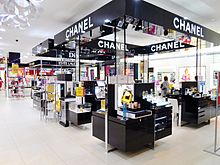Industry

The manufacture of cosmetics is dominated by a small number of multinational corporations that originated in the early 20th century, but the distribution and sales of cosmetics is spread among a wide range of businesses. The world's largest cosmetic companies are L'Oréal, Procter & Gamble, Unilever, Shiseido, and Estée Lauder. In 2005, the market volume of the cosmetics industry in the US, Europe, and Japan was about EUR 70 Billion/a year. In Germany, the cosmetic industry generated €12.6 billion of retail sales in 2008, which makes the German cosmetic industry the third largest in the world, after Japan and the United States. German exports of cosmetics reached €5.8 billion in 2008, whereas imports of cosmetics totaled €3 billion.
The worldwide cosmetics and perfume industry currently generates an estimated annual turnover of US$170 billion (according to Eurostaf – May 2007). Europe is the leading market, representing approximately €63 billion, while sales in France reached €6.5 billion in 2006, according to FIPAR (Fédération des Industries de la Parfumerie – the French federation for the perfume industry).unreliable source? France is another country in which the cosmetic industry plays an important role, both nationally and internationally. According to data from 2008, the cosmetic industry has grown constantly in France for 40 consecutive years. In 2006, this industrial sector reached a record level of €6.5 billion. Famous cosmetic brands produced in France include Vichy, Yves Saint Laurent, Yves Rocher, and many others.
The Italian cosmetic industry is also an important player in the European cosmetic market. Although not as large as in other European countries, the cosmetic industry in Italy was estimated to reach €9 billion in 2007.citation needed The Italian cosmetic industry is dominated by hair and body products and not makeup as in many other European countries. In Italy, hair and body products make up approximately 30% of the cosmetic market. Makeup and facial care, however, are the most common cosmetic products exported to the United States.
According to Euromonitor International, the market for cosmetics in China is expected to be $7.4 billion in 2021 up from $4.3 billion in 2016. The increase is due to social media and the changing attitudes of people in the 18-to-30-year age bracket.
Due to the popularity of cosmetics, especially fragrances and perfumes, many designers who are not necessarily involved in the cosmetic industry came up with perfumes carrying their names. Moreover, some actors and singers (such as Celine Dion) have their own perfume line. Designer perfumes are, like any other designer products, the most expensive in the industry as the consumer pays for the product and the brand. Famous Italian fragrances are produced by Giorgio Armani, Dolce & Gabbana, and others.
Procter & Gamble, which sells CoverGirl and Dolce & Gabbana makeup, funded a study concluding that makeup makes women seem more competent. Due to the source of funding, the quality of this Boston University study is questioned.
Cosmetics products may be retailed in beauty stores, department stores and hypermarkets, drugstores, variety stores, grocery stores, beauty supply stores, and many other formats, and in similar types of online stores or the online presence of these types of physical stores.
Comments
Post a Comment